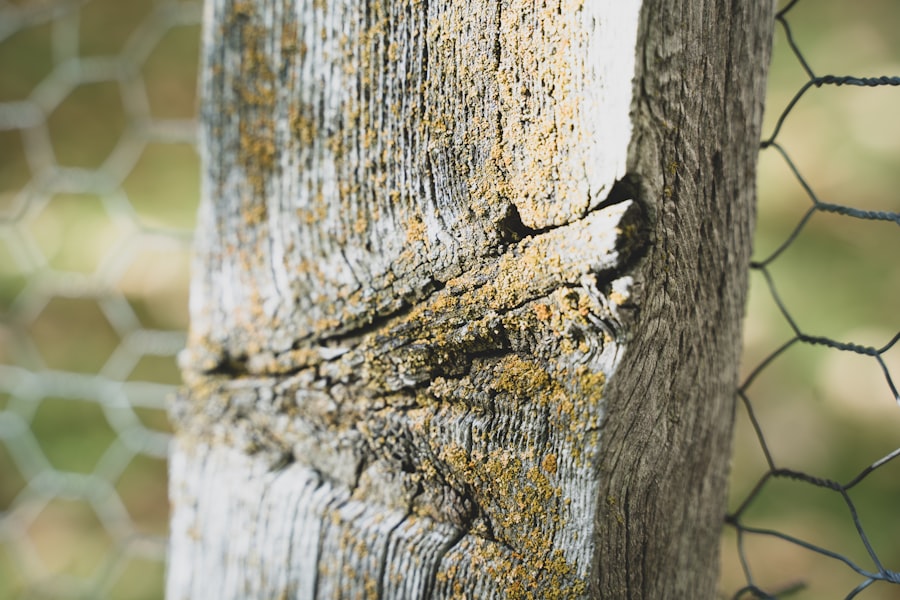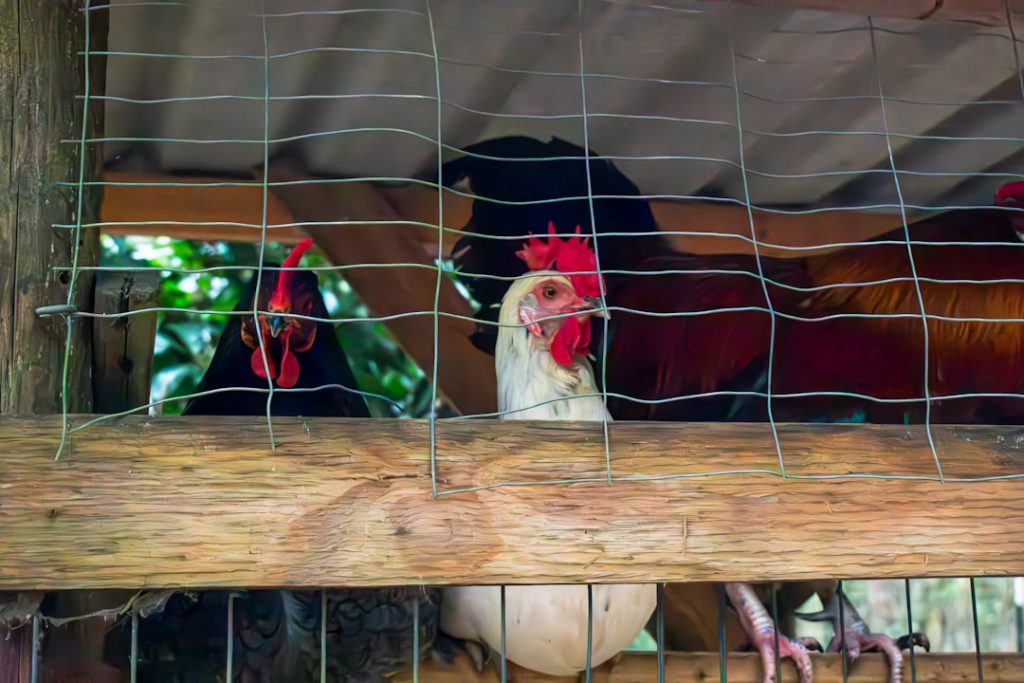Proper fencing for chickens is crucial for their safety and well-being. Chickens are natural foragers and may wander into dangerous areas if not contained. They are vulnerable to predators such as foxes, raccoons, and birds of prey, making secure fencing essential for protection.
A good fence also prevents chickens from damaging gardens and flower beds, and helps avoid conflicts with neighbors by keeping the birds on their designated property. Appropriate fencing helps protect the surrounding environment by managing and controlling the chickens’ impact on the local ecosystem. This is particularly important in urban and suburban areas where space is limited, and the presence of chickens may significantly affect the local environment.
Secure fencing also contributes to the safety of other animals and people in the area. It prevents chickens from wandering onto roads or neighboring properties, potentially causing accidents or conflicts. A well-constructed fence can help minimize the spread of diseases and parasites between chickens and other animals, maintaining the health of the local ecosystem.
In summary, proper fencing for chickens is essential for protecting the birds, preserving the surrounding environment, and ensuring the safety and well-being of other animals and people in the area.
Table of Contents
- 1 Factors to Consider When Determining Fence Height for Chickens
- 2 Recommended Fence Heights for Different Breeds of Chickens
- 3 Potential Risks of Inadequate Fencing for Chickens
- 4 Tips for Installing and Maintaining Chicken Fencing
- 5 Alternatives to Traditional Fencing for Keeping Chickens
- 6 Finding the Right Fence Height for Your Chickens
- 7 FAQs
- 7.1 What is the recommended height for a fence to keep chickens in?
- 7.2 Why is a 6-foot fence recommended for keeping chickens in?
- 7.3 Are there any other factors to consider when determining the height of a fence for keeping chickens in?
- 7.4 Can other measures be taken to keep chickens from flying over a fence?
Key Takeaways
- Proper fencing for chickens is important for their safety and protection from predators.
- Factors to consider when determining fence height for chickens include the size and breed of the chickens, as well as the potential threats from predators in the area.
- Recommended fence heights for different breeds of chickens vary, with larger breeds requiring taller fences to prevent them from flying over.
- Inadequate fencing for chickens can lead to risks such as predation, injury, and escape, which can be detrimental to the well-being of the chickens.
- Tips for installing and maintaining chicken fencing include using sturdy materials, regularly inspecting for damage, and securing the bottom of the fence to prevent digging predators.
- Alternatives to traditional fencing for keeping chickens include electric fencing, netting, and using natural barriers like hedges or bushes.
- Finding the right fence height for your chickens is crucial for their safety and well-being, and should be determined based on the specific needs and characteristics of your flock.
Factors to Consider When Determining Fence Height for Chickens
Chicken Size and Breed
The size and breed of the chickens are crucial factors to consider. Larger breeds, such as Orpingtons and Brahmas, may require taller fences to prevent them from flying over or escaping. On the other hand, Bantam breeds may be content with lower fences due to their smaller size and reduced ability to fly long distances.
Age and Predators
The age of the chickens should also be considered when determining fence height. Younger chickens may be more agile and prone to escaping, while older chickens may be less likely to attempt to fly over a fence. Additionally, the presence of predators in the area, such as foxes, raccoons, or birds of prey, is a critical factor. A fence tall enough to deter these animals from attempting to breach it is essential.
Terrain and Purpose
The terrain surrounding the chicken coop should also be taken into account when determining fence height. If the area is hilly or uneven, a taller fence may be necessary to prevent chickens from finding high ground and escaping over the top. Furthermore, the purpose of the fence is vital. If the primary goal is to keep chickens contained within a specific area, a lower fence may be sufficient. However, if the fence is intended to provide protection from predators or to prevent chickens from causing damage in neighboring areas, a taller fence may be necessary. The materials used to construct the fence, such as wire mesh, solid wood, or vinyl, should also be considered when determining the appropriate height.
Recommended Fence Heights for Different Breeds of Chickens

The recommended fence height for different breeds of chickens can vary depending on their size, agility, and ability to fly. For larger and more active breeds such as Orpingtons, Brahmas, and Rhode Island Reds, a fence height of at least 6 feet is recommended to prevent them from flying over or escaping. These breeds are known for their strong flying abilities and may require taller fences to keep them contained within a designated area.
On the other hand, smaller breeds such as Silkies and Bantams may be content with fences as low as 3-4 feet due to their smaller size and reduced ability to fly long distances. In addition to considering the size and flying abilities of different breeds, it is also important to take into account their behavior and temperament when determining fence height. Some breeds may be more prone to attempting to escape or fly over fences, while others may be content staying within a designated area.
For example, Mediterranean breeds such as Leghorns and Anconas are known for their active and independent nature and may require taller fences to prevent them from escaping. Overall, when determining fence height for different breeds of chickens, it is important to consider their size, flying abilities, behavior, and temperament. Another factor to consider when determining recommended fence heights for different breeds of chickens is their age and stage of development.
Younger chickens may be more agile and prone to attempting to escape over fences, while older chickens may be less likely to do so. Additionally, some breeds may mature at different rates and exhibit different behaviors as they grow older. For example, some breeds may become more active and adventurous as they reach maturity, requiring taller fences to keep them contained.
Overall, when determining recommended fence heights for different breeds of chickens, it is important to consider their age, stage of development, and potential changes in behavior as they mature.
Potential Risks of Inadequate Fencing for Chickens
Inadequate fencing for chickens can pose several risks to their safety and well-being. One of the most significant risks is the potential for predators to breach the fence and attack or kill the chickens. Predators such as foxes, raccoons, dogs, and birds of prey are known to target chickens as easy prey if they are not properly contained within a secure enclosure.
Inadequate fencing can also lead to conflicts with neighbors if chickens wander onto neighboring properties and cause damage or disturbances. Additionally, inadequate fencing can result in chickens wandering onto roads or into other hazardous areas where they may be injured or killed. Another potential risk of inadequate fencing for chickens is the spread of diseases and parasites between chickens and other animals.
If chickens are not properly contained within a designated area, they may come into contact with wild birds or other animals that carry diseases or parasites. This can lead to outbreaks of illness among the chicken flock and potentially spread diseases to other animals in the area. Inadequate fencing can also result in chickens causing damage to gardens, flower beds, and other areas where they may roam freely.
This can lead to conflicts with neighbors and damage relationships within the community. In addition to posing risks to the safety and well-being of the chickens themselves, inadequate fencing can also have negative impacts on the surrounding environment. Chickens that are not properly contained within a designated area may have a significant impact on local ecosystems by disturbing native plants and wildlife.
They may also contribute to soil erosion and water pollution if allowed to roam freely in sensitive areas such as wetlands or riparian zones. Overall, inadequate fencing for chickens can pose significant risks to their safety and well-being, lead to conflicts with neighbors, contribute to the spread of diseases and parasites, and have negative impacts on the surrounding environment.
Tips for Installing and Maintaining Chicken Fencing
When installing chicken fencing, there are several tips that can help ensure its effectiveness and longevity. The first tip is to use high-quality materials that are durable and resistant to wear and tear. This includes using sturdy posts that are securely anchored in the ground and using strong wire mesh or fencing material that is difficult for predators to breach.
Additionally, it is important to regularly inspect the fencing for any signs of damage or weakness and make repairs as needed. This includes checking for loose or broken posts, damaged wire mesh, or areas where predators may have attempted to breach the fence. Another tip for installing and maintaining chicken fencing is to consider adding additional deterrents such as electric fencing or predator-proofing measures.
Electric fencing can provide an additional layer of protection by delivering a mild shock to predators that attempt to breach the fence. Additionally, predator-proofing measures such as burying wire mesh underground or adding an apron of wire mesh around the perimeter of the fence can help prevent predators from digging under or climbing over the fence. These additional deterrents can help enhance the effectiveness of the fencing and provide added security for the chickens.
It is also important to regularly monitor the behavior of the chickens and make adjustments to the fencing as needed. This includes observing any attempts by the chickens to escape or breach the fence and making modifications to prevent future escape attempts. For example, if chickens are found roosting on top of the fence or attempting to fly over it, additional measures such as adding netting or extending the height of the fence may be necessary.
By regularly monitoring chicken behavior and making adjustments to the fencing as needed, it is possible to maintain a secure enclosure that effectively contains the chickens and protects them from predators.
Alternatives to Traditional Fencing for Keeping Chickens

Portable Electric Netting
One alternative option is using portable electric netting or poultry netting that can be easily moved around as needed. This type of fencing provides flexibility in managing chicken enclosures and allows for easy rotation of grazing areas without having to install permanent fencing structures. Portable electric netting can also provide an additional layer of protection against predators by delivering a mild shock if they attempt to breach the fence.
Chicken Tractors and Mobile Coops
Another alternative option for keeping chickens contained is using chicken tractors or mobile coops that can be moved around on a regular basis. Chicken tractors provide a secure enclosure for chickens while allowing them access to fresh grass and insects in different areas of a property. By regularly moving chicken tractors to new locations, it is possible to prevent damage to vegetation in one area while allowing it time to recover before returning with the chickens. This method also helps prevent soil compaction in one area by rotating grazing locations.
Natural Barriers
Additionally, natural barriers such as hedges or shrubs can be used as an alternative method for containing chickens within a designated area. Planting dense hedges or shrubs around the perimeter of a chicken enclosure can provide a natural barrier that prevents predators from breaching the fence while also providing additional shelter and habitat for wildlife. Natural barriers can also help create a more aesthetically pleasing enclosure that blends in with the surrounding landscape.
Finding the Right Fence Height for Your Chickens
In conclusion, finding the right fence height for your chickens is essential for their safety and well-being as well as for protecting surrounding areas and maintaining positive relationships with neighbors. When determining fence height for chickens, it is important to consider factors such as breed size, flying abilities, behavior, age, presence of predators, terrain, purpose of the fence, materials used in construction, and potential changes in behavior as they mature. It is crucial to install high-quality fencing materials that are durable and resistant to wear and tear while regularly inspecting and maintaining the fencing for any signs of damage or weakness.
Additional deterrents such as electric fencing or predator-proofing measures can provide added security for your chickens while regularly monitoring their behavior can help make necessary adjustments to prevent escape attempts. In addition to traditional fencing methods, alternative options such as portable electric netting, chicken tractors, mobile coops, natural barriers can provide flexibility in managing chicken enclosures while providing additional protection against predators. By carefully considering these factors and implementing appropriate measures, you can find the right fence height for your chickens that effectively contains them within a designated area while protecting them from predators and preventing conflicts with neighbors.
If you’re considering building a chicken coop, you may also want to think about whether or not turkeys need a coop. According to a helpful article on Poultry Wizard, turkeys do indeed need a coop to keep them safe and secure. The article discusses the importance of providing turkeys with a coop that is large enough to accommodate their size and includes tips for keeping them comfortable and healthy. For more information on this topic, you can read the full article here.
FAQs
What is the recommended height for a fence to keep chickens in?
The recommended height for a fence to keep chickens in is at least 6 feet tall. This height will prevent most breeds of chickens from flying over the fence.
Why is a 6-foot fence recommended for keeping chickens in?
A 6-foot fence is recommended for keeping chickens in because it is tall enough to prevent most breeds of chickens from flying over it. This height helps to ensure that the chickens remain safely contained within the fenced area.
Are there any other factors to consider when determining the height of a fence for keeping chickens in?
In addition to the height of the fence, it’s important to consider the breed of chickens being kept, as some breeds are better flyers than others. Additionally, the presence of any nearby predators should also be taken into account when determining the height of the fence.
Can other measures be taken to keep chickens from flying over a fence?
In addition to a tall fence, other measures such as clipping the chickens’ wings or using netting over the fenced area can also help prevent chickens from flying over the fence. These measures can be used in conjunction with a properly sized fence to ensure that the chickens remain safely contained.
Meet Walter, the feathered-friend fanatic of Florida! Nestled in the sunshine state, Walter struts through life with his feathered companions, clucking his way to happiness. With a coop that’s fancier than a five-star hotel, he’s the Don Juan of the chicken world. When he’s not teaching his hens to do the cha-cha, you’ll find him in a heated debate with his prized rooster, Sir Clucks-a-Lot. Walter’s poultry passion is no yolk; he’s the sunny-side-up guy you never knew you needed in your flock of friends!







